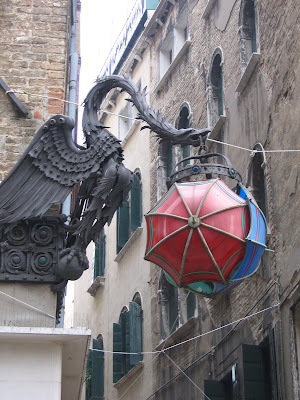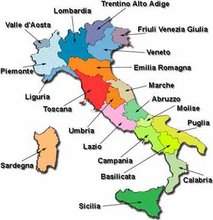Sunday mid-day we headed out from Verona to Venice. Venice is made up of more than 117 islands, 150 canals, and 409 bridges. The Grand Canal weaves for 3.5km through the city from the train station all the way to Piazza San Marco. Only three bridges cross the Grand Canal: Ponte di Rialto, Ponte dell'Accademia, and the Ponte dei Sclazi (pictured below).
We decided to head towards San Marco. We considered taking the vaporetto but it cost 6 Euros per person one-way. Instead we opted to to walk!
First Images of Venezia from the train station:

Grand Canal looking from the Ponte dei Sclazi.

Oliver enjoying his first trip to Venice.

We decided to head towards San Marco by walking through the Santa Croce sestieri (district). It is quite fun to just wander the through Venice especially if you have lots of time. It can sometimes get a little confusing though.....

Which Way? In Venice they use different terms to indicate streets etc. For example, in Italy a street is called via but in Venice, calle. Still it is very relaxing to be able to wander the streets and not to worry about cars or scooters. We were heading in the direction of Rialto because we wanted to head over to the Rialto Markets, hoping that they were open on Sunday (they were not). Apparently they have a giant seafood market 5 times a week and a produce market 6 days a week. That will be for next time!

A Venetian door. One thing that is charming about Venice is it's uniqueness. I read that the best way to see the nicest parts of Venice is to take a Gondola (too bad the going rate is 100 Euros for half hour!) or a vaporetto because Venetian homes/buildings have two entrances: the canal entrance and the street entrance. Because so many people traveled by boat, the canal entrance is often a lot nicer than the street entrance....

Even though this door is falling apart you can see that the canal entrance pictured below is quite ornate. It is also interesting to notice that the steps are submerged under water: an indication of either the rising tides or the sinking city!

Ollie with the Grand Canal near Rialto and the Campo di Pescheria (fish market).

The Rialto Bridge was for many years the only bridge that crossed the Grand Canal. Rialto or rivo alto means high bank and this spot was considered one of the safest in the lagoon and consequently was one of the earliest settled locations in Venice. Today, there is a produce market and there has been a market in this location for almost 1,000 years!

View from the Rialto Bridge.

One of things about Venice that I like is the different colors. The colors seem a little brighter, possibly because there is little pollution from cars!



After crossing the Rialto we were headed to San Marco. A very ornate light fixture on a street corner: a dragon and umbrellas. We are not sure if this has some sort of meaning.

In this particular area (between Rialto and San Marco) there were loads of stores (more high-end then near the Ponte dei Sclazi and the train station). There were tons of masks for Carnevale, which is held this year from January 25-Feb 5. Some of the nicer masks were over 400 Euros!

The word carnival comes from the Latin word for "Farewell Meat!" Since lent required people to fast, during the period leading up to Ash Wednesday, all the meat, butter, and eggs needed to be used up.
The history of the Venice carnival tradition dates back to 1162 after the Venetians defeated Ulrico. At this time, a tradition of slaughtering one bull and 12 pigs in San Marco began to commemorate the victory. Over time, the tradition became more popular. The first documented use of masks during this celebration was in 1268!
The 18th century was the heyday of the Carnival. Venice's decline in power was accompanied by a conspicuous consumption of pleasure.
The Carnival declined through the 1930s when Mussolini banned it. In 1979, a group of Venetians revived the tradition.

Masks made the Venetian Carnival unique. If you could not identify the wearer of the mask, you did not know that person's social status. In this way, the social order in Venice was temporarily overturned, even if it was just for a few days.

Gondolas and Gondoliers: At almost every turn you can see a small canal and gondolas docked, ready to take someone for a ride. Because this is one of the low-season periods (right before Christmas) we saw more gondoliers sitting around than working! A gondolier under Venetian law, must have been born in Venice to practice this trade. During the 18th century, there were as many as several thousand gondoliers; today there are a few hundred (425 according to a recent NY Times article). Recently there has been controversy over the fact that a woman has won the right to operate a gondola in Venice. To read more about this, check out the New York Times article On the Canals, a Woman Paddles Against The Tide. An interesting aspect of the article is the sexism that exists in Venice. Up until 8 years ago, women were not allowed to wait on tables at cafes in Piazza San Marco, only men were allowed to!

Gondolas are traditional Venetian boats that for centuries were the main form of transportation. Today when you walk around Venice all the gondolas are black. Prior to a decree by the Doge (chief magistrate) in 1562 gondolas were muti-colored; the colors and materials used showcased the wealth of the owner. The decree of 1562 said that all gondolas must be black except those that were "transporting important people." To this day, all gondolas are black.
An interesting aspect of gondolas is that they are asymmetrical; the left side is wider to counter balance the gondolier standing of the left and the use of the oar on the right.

The Torre dell'Orologio stands at the entrance to Piazza San Marco. It was built in the 14th century and displays the hours of the day, the phases of the moon, and the movement of the sun through the signs of the zodiac.

Basilica San Marco: the original basilica (which was quite small) was destroyed by fire in the 10th century and then rebuilt in 1063. The basilica is built on the plan of the Greek cross and has 5 large domes, some of which are unfortunately under scaffolding right now. San Marco did not become Venice's cathedral until 1807!
In the picture below it is possible to see replicas of the gilded bronze horses which were stolen and brought to Venice after the fall of Constantinople. The originals are on display inside the basilica.

Once again, the lion, the symbol of the Venetian republic.

The facade of the basilica is adorned with colorful mosaics, some of which depict events in the life of Saint Mark, including bringing his body back to Venice.


The story of St. Mark and the basilica is quite interesting. According to legend, when the evangelist Mark was in Venice (the actual city did not exist), a winged fellow told Mark, the future saint, that his body would eventually rest in the city of Venice. When Mark died in Egypt, two Venetians persuaded the guards at Mark's tomb to allow them to take him back to Venice so that he could become the patron saint of Venice. There is speculation that the doges may have been behind this and even more speculation that the body that was brought back to Venice might have not been that of St. Mark. Regardless, everyone believed that it was his body and the doge ordered the construction of a new basilica to hold his remains. In the book of Revelation, Mark is symbolized by a winged lion, and this same symbol became synonymous with that of Venice.

Outside the basilica there are numerous columns, all made of different marble.


On the side of the Basilica is the Palazzo Ducale, also known as the Doge's Palace. It served as the doge's official residence, and the seat of the Republic's government, bureaucracy, and prisons.
The term "Doge" was used for the chief magistrate in the city of Venice. Doges of Venice were elected for life by the aristocracy of the city-state. The doge was frequently the shrewdest elder in the city.
In the picture below it is possible to see some of the domes of the Basilica of St. Mark.

The Palazzo Ducale has a Gothic facade, with the two most visible facades facing the Venetian Lagoon and Piazza San Marco. The building is quite impressive!

For centuries, the Palazzo Ducale was the only building in Venice that was allowed to be referred to as a palazzo. All other buildings were called Ca', short for the word casa.

The Doge Palace was also a prison; Casanova was imprisoned here and escaped in 1755. Today there is an interesting tour called Itinerari Segreti (Secret Itineraries) which takes you through the palace to lesser known parts, including the civil servant's offices, the torture chamber, and the Piombi (prison cells beneath the roof of the building). It was in the piombi that Casanova was imprisoned. Both Reed and I really want to do this on our next trip to Venice!




Behind the street lamp it is possible to see one of the two columns that dominate this end of the piazza that bear the statues of the lions of St. Mark and St. Theodore, the two patron saints of the city. This area was originally a marketplace and was also the common site of executions.


Gondolas in the Venetian Lagoon.

This is the Bridge of Sighs, also known as the Ponte dei Sospiri. The bridge was built in 1600 to connect the Doge's prisons (prigioni) with the inquisitor's rooms in the main palace. The view from the Bridge of Sighs was the last view of Venice that convicts saw before being imprisoned. The bridge was built by Antoni Contino and the name "Bridge of Sighs" was only invented in the 19th century when Lord Byron helped to popularize the belief that the bridge was inspired by the sighs of condemned prisoners as they were led through it on their way to be executed.

Ollie and I with the gondolas.

After seeing the sights in San Marco we decided to head off to find the Palazzo Contarini del Bovolo, which is quite unique. On the way we passed Harry's Bar (we did not stop in).

A very ornate church along the way.

I had to get a picture of this: A street with my birthday as the name!

This canal was super stinky. Even though it was a cool December day, every once and a while it smelled quite horrible. I can only imagine the smell in July or August!

We finally arrived at the Palazzo Contarini del Bovolo - a small palace in Venice best known for the external spiral staircase with arches.

The palace dates back to the 15th century and is a less touristy area, near the Campo Manin and the Rialto bridge.

The palazzo gets it name from the Venetian word bovolo, meaning snail shell.

Ollie in front of a delicatessen while Reed went in to buy a bottle of Prosecco for dinner at Lawren and Steve's.

Napoleon once said that Piazza San Marco is the "finest drawing room in Europe." Because of this, he declared that Piazza San Marco is the only square worthy of the name Piazza. Consequently, all other squares are called campo which means field.

The decorations were all up for Christmas.

Before heading home, we headed over to a Christmas market that had just been put up. It was quite festive.
 We were hoping that there might be some venetian treats such as mandolato, a Venetian dessert that is a cross between toffee and nougat that we were interested in trying but had not been able to find. It seemed that this particular market had more tuscan food than venetian-go figure!
We were hoping that there might be some venetian treats such as mandolato, a Venetian dessert that is a cross between toffee and nougat that we were interested in trying but had not been able to find. It seemed that this particular market had more tuscan food than venetian-go figure!
It was nice to see all the lights and Christmas decorations up! Hopefully Siena gets in the spirit soon!

With so much left to see in Venice, we will have to just go back!
"Venice is not only a city of fantasy and freedom. It is also a city of joy and pleasure."
Peggy Guggenheim
Peggy Guggenheim








No comments:
Post a Comment